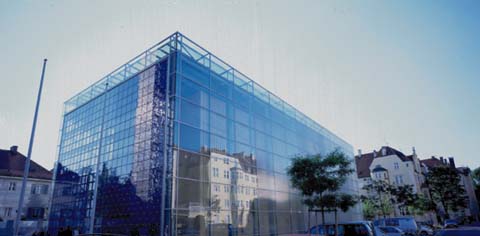| The effect of light transformation
Of course, the diversity of these layers is not solely dependent simply on the difference in materials. With the glass film, which physically separates the external world from the internal world, as one travels further and further into the church, the penetrating light gradually transforms from transparent to translucent, and then transforms into a white light, offering a sequence of transforming light. The front doors, at over 16 meters high and 18 meter wide, serve as “doors on earth” that lead to a sacred space. The doors, decorated a bold shade of blue, were built in traditional church construction style to be "big and heavy".
Meanwhile, the interior layer made of maple with a louvered configuration filters the natural light coming through the outer shell of the glass. This process causes physical light to be sublimated into metaphysical light. As for the direction of the louver, the first level is designed so that light coming in from the south is not directed toward the attendees because those who are attending church should focus their attention toward the altar. The second level, on the other hand, is set at a fixed angle so that light radiates from the front of the building, forcing a concentration of light on the altar as well as creating an effect of “light” from the altar lighting up the external world. Furthermore, in the front of the building, golden light emanating from brass textiles creates a large image of a cross. At night, the entire building glows.
|
| |
| A space brimming with symbolism, bridging heaven and earth
Biblical events, from the Crucifixion to Resurrection to the Second Coming, are depicted in this church. Starting with the glass on the large front doors, the story of the Crucifixion is illustrated through letters of the alphabet, using “nails”, a symbol of the Crucifixion of Christ, as a motif. Next, displayed in the side corridor, are 14 photographs of “The Road to Crucifixion” showing historical remnants in the Holy Land of Jerusalem. Furthermore, a gently sloping stone floor, similar to those of churches in ancient Roman times, was constructed. The floor gradually becomes more and more polished as one travels away from the plaza and towards the altar, creating the effect of entering a graceful world. Five holes are dug out in the floor in which five elements of Christ’s “body” - to signify areas in which Christ was beaten, such as His head, chest, hands and feet - rise up in white spaces. In addition, the brass tapestries at the front of the church signify the holy light that shone on “The Day of His Resurrection”. As in the brass in front of the church, the Virgin Mary statue and the sacristy are also delicately created using brass.
|
|
(written by editor) |
|
